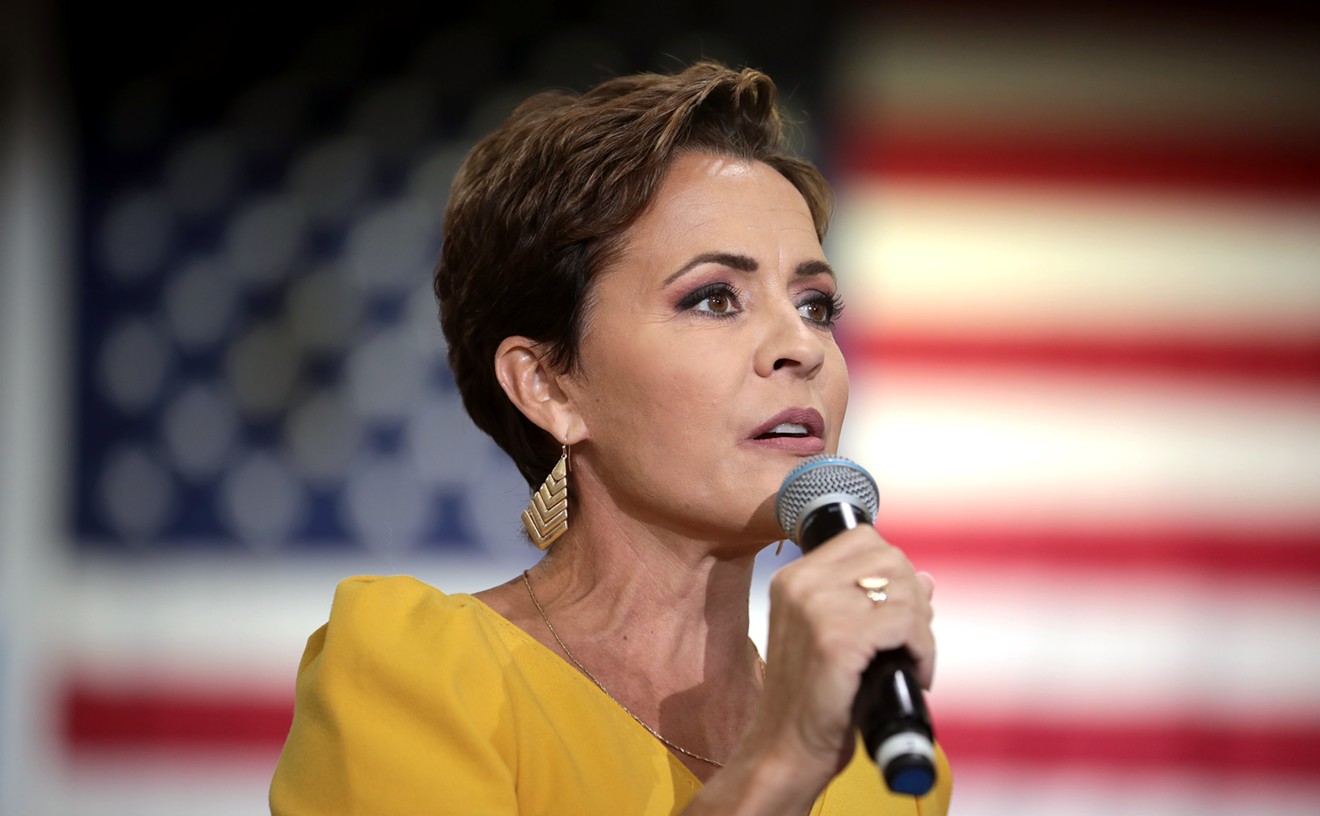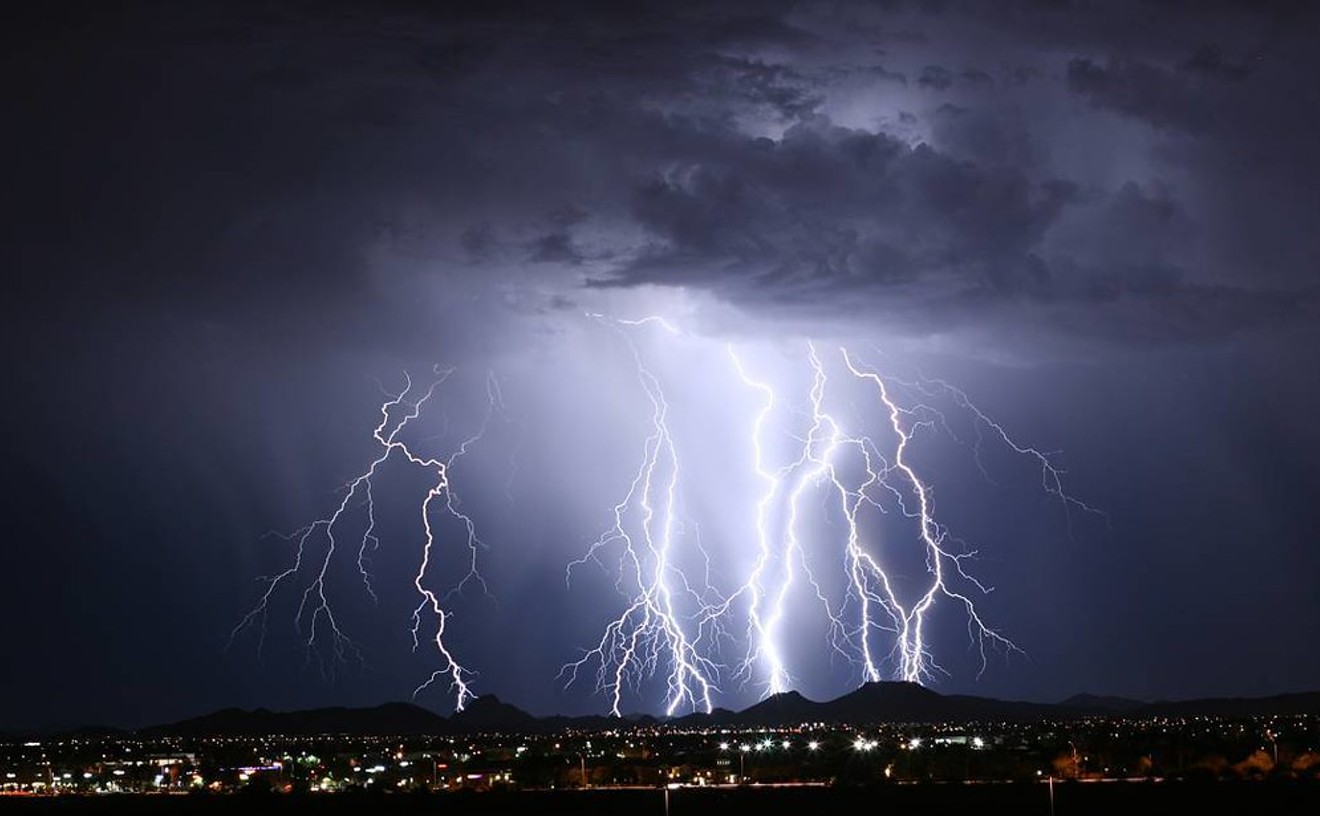Latest updates from Friday, April 27:
Arizona Walkout Continues as Lawmakers Strike Deal on 20 Percent Raise
Chandler School District Flip-Flops, Decides to Extend Strike to Monday
Solidarity in Small-Town Arizona: A Rural #RedForEd Movement Emerges
Arizona Teacher Walkout Causes Stress for Some Parents and Teachers
The first mass teacher strike in state history wrapped up a massive demonstration of an estimated 50,000 marchers at the Capitol around 1 p.m. on Thursday, ending prematurely because of the rising heat.
People in the crowd booed when the Vice President of AEA Marisol Garcia told them that the Legislature had adjourned for the weekend. But the temperature was climbing to about 95 degrees and people were beginning to wilt in the heat. Garcia said the rally would end early to keep people safe.
Before it ended, Garcia told the crowd, "Look around," Garcia said. "We’re going to win ... Be proud."
She told the crowd to return Friday morning with ice water and clothing fit for the heat.
Later, teachers gathered by the northwest corner of the Capitol grounds, getting ready to leave.
"On sight, we were floored by the numbers," said Melissa Scroggins, a teacher at Southwest Elementary in Phoenix’s Roosevelt Elementary School District. Scroggins attended the rally with two fellow teachers from her school, Gabe Mendoza and Nubia Ornelas.
Scroggins said that she wanted to demonstrate to her students a kind of civics lesson: "If you want change, you actually have to go out here and get it."
The classrooms at Southwest Elementary are overcrowded with as many as 35 students, Orneles said, and sometimes they run out of desks and chairs.
The heat didn’t bother the teachers too much. What did irk them, however, was that the Legislature had adjourned unexpectedly for the weekend, with no sign of a deal on raising pay or increased school funding. On Thursday afternoon, Ducey’s office released a statement that said the governor met with “10 educators — teachers, counselors, school psychologists — from around the state who were here at the Capitol for the RedforEd march.”
From the perspective of these teachers, the governor seemingly ignored #RedForEd.
"In my mind, I was expecting us to at least be answered. It's like you’re knocking at the door, and there's no answer," Scroggins said, adding, "They knew this event was coming."
Politicians will have another chance to address the teachers’ concerns: By 11 a.m. tomorrow, educators will be back at the Capitol, according to the #RedForEd organizers.
Scroll down for the updates made on this story throughout the day:
Classrooms are empty and most public schools statewide are closed on the first day of Arizona's teacher walkout for better pay and increased school funding.
Teachers are taking a bold gamble to force lawmakers to act. Arizona teachers are among the lowest-paid in the nation, and they want a 20 percent raise, plus per-pupil funding that matches the national average.
Now, the question is whether the walkout can succeed in the face of tax-averse lawmakers.
1-1:30 p.m.: #RedForEd leaders address tens of thousands of teachers at Capitol
Joe Thomas, president of the Arizona Education Association, addressed the throngs of people on a stage directly in front of the Capitol dome.
“Stay strong," he said. "Believe in the person next to you — believe in every single person wearing red, because they want the same thing you do: better schools all across the state."
Thomas told the tens of thousands of people to look toward the ninth floor of the state Capitol tower, which houses the governor’s office.
“You see it? Everybody wave!” Thomas said.
They did, raising a loud cheer at the same time.
The governor has proposed a 20 percent raise for teachers by 2021, but the AEA and #RedForEd leaders are asking for broader school funding increases and raises that also include support staff. Whether they’ll be able to keep up the pressure is unclear. Thomas made it sound like the movement isn’t stopping anytime soon.
“We are in the middle of a moment and we have to stand strong until the end,” he said. “And then we go back, we look our kids in the eye and say, ‘We ask you to give us your best — we gave you our best.’”
Rebecca Garelli, one of the #RedForEd leaders and a teacher at Phoenix's Alhambra Elementary, demanded in her speech that the Legislature restore funding to 2008 levels.
“What do we want?”
“Funding!” the crowd screamed.
“When do we want it?”
“Now!”
1 p.m.: Yes, this event is as big as it looks
Phoenix police estimate the crowd size at 50,000.
12:45 p.m.: The red sea
Two teachers stopped to catch their breath outside of the Arizona State Agriculture building as the march neared the Capitol: Mark Muradian, a teacher at Independence High School in the Glendale Union High School District, and Robin Johnson, of Creighton Elementary in Phoenix.
They were shocked to see a constant stream of people in red still moving toward the Capitol a full hour after the march began. Muradian hoped it would send a simple message: Teachers want to see a sustainable source of school funding and yearly raises, he said.
Johnson, a science teacher, said she has not had a raise in 10 years and earns around $41,000, even with a master's degree. Even worse are the learning conditions for her students.
"My science books are copyright 2004,” she said. “It’s so bad that sometimes our students don’t even have toilet paper in the bathrooms."

An estimated crowd of 50,000 march the streets of Phoenix on their way to the Capital.
Photo Courtesy of Ironwood PTO
12 noon: Teachers and supporters converge to demand better pay
The March route wound from Chase Field toward Jackson Street, north on Third Avenue, and west all the way to the State Capitol on Washington Street.
People pounded drums as others chanted “Red for Ed!” Someone in the mass of people was playing the tuba. A group of students carried a speaker and sang along as it blasted, "We’re not gonna take it!"
Deborah Howard, 61, held a sign that said, “Stay strong, we support you.”
The retired public affairs consultant was at the Capitol to support the push to fully fund Arizona schools. Millions of dollars were cut and never restored after the 2008 recession, even as Arizona legislators cut taxes.
“It’s time to restore that funding, and without tricks and shell games,” Howard said. “This is the job of state government: to fund education,” she added. “They need to do their job.”
11:30 a.m.: Thousands of teachers march to the Arizona State Capitol
11 a.m. Going to the Capitol
Thousands of teachers dressed in red gathered at Chase Field to get ready to march to the Capitol. Traffic slowed to a crawl near Chase Field, where people were grabbing water bottles and hoisting signs. The light rail in downtown Phoenix was packed, and pretty much everyone in the train cars was wearing red.
Mark Peterman, a 44-year-old freelance photographer, was waiting at the Central Avenue station near ASU’s downtown campus with his third-grade daughter Maisy, a student in the Tempe Elementary School District. They decided not to elbow their way onto a train where people were practically spilling out of the doors, and instead waited for the next one on their way to the Capitol.
Peterman supports the walkout and is watching carefully to see if teachers earn a raise as a result. At the same time, Peterson acknowledged that parents will be anxious to see the walkout end.
April 26 happens to be national “Take Your Child to Work Day,” so it worked out that Peterman ended up hanging out with his daughter because of his relatively flexible freelance schedule.
9:30 a.m.: Teachers preparing for march to Capitol
On Polk Street near 12th Avenue, two sisters were setting up their lawn as a gathering point for friends and teachers before heading to the Capitol as a group later today.
Jeisenia Estrada, 21, is a contracted student-teacher at Sahuaro Elementary in the Washington School District. She attends Arizona State University, and supports the walkout wholeheartedly. "I think it’s really necessary for all of us," she said.
Her sister Janet Estrada, 24, is a stay-at-home mom, so she was able to keep an eye on her kids without worrying about what they would do while schools are closed.
9:30 a.m. Private school open as normal
A few miles to the north at Xavier College Preparatory, it seemed like the strike was happening in a different state. A long line of cars moved slowly across the Spanish Colonial-style campus as parents dropped off their kids at the private high school.
Xavier maintenance employee Phillip Segura, 59, was serving as a crossing guard, and told one student after another to have a great day as they trudged to class. But Segura acknowledged that the situation at Xavier was unusual — thousands of students at districts across the state are not in class this morning.
"I have a lot of nephews and nieces who aren’t going to school," he said.
9:30 a.m.: Phoenix facilities are open for kids who suddenly have time off
On the south side of Phoenix, Steve Colter, a facility manager and recreation coordinator with the city’s Parks and Recreation department, was watching a pair of kids play basketball in the Harmon Park gymnasium near Buckeye Road.
The city of Phoenix opened two dozen recreation centers for extended hours during the strike. "We’re trying to make sure the kids have access when they're not in school," Colter said.
It was still early, so the recreation center was mostly quiet except for the kids lobbing free throws, but Colter said he expects parents to stop by later when they drop their kids off at the recreation center before going to work.
"We’ll have lunch for them when they show up," he said. What he doesn’t want is for kids to be unsupervised and have free rein to roam around while schools are closed.
9:26 a.m.: Coincidence?
Well we got no class.. and we got no principles 46 years ago today School’s Out was released. pic.twitter.com/0W9qqu0R4V
— Alice Cooper (@alicecooper) April 26, 2018
9:11 — New Times reader Matt Hamilton submits photo of light-rail station packed with red shirts
8:45 a.m.: Teachers in rural areas show their support.
#RedForEd #SupportEducation #RezForEd
— teresa. (@tere_____) April 26, 2018
Teachers and Students this morning in Tuba City showing support for those walking out in AZ & Co @abc15 @azfamily @azcentral @azds pic.twitter.com/KWtqKO5Ad9
7:59: Talk show host rips #RedForEd leader
The virus is spreading. #RedForEd Noah Karvelis is Arizona’s David Hogg. Idealistic. Ignorant. Influential! pic.twitter.com/CtSLbWBOsi
— James T Harris (@JamesTHarris) April 26, 2018
7:28 a.m: Governor says he supports teachers
Without a doubt, teachers are some of the biggest difference-makers in the lives of Arizona children. They need to be respected, and rewarded, for the work they do -- and Arizona can do better on this front. 1/3
— Doug Ducey (@dougducey) April 26, 2018
Wednesday: Teachers kick off strike
On Wednesday afternoon, teachers with the grassroots #RedForEd movement and the Arizona teachers' union kicked off the strike in a news conference. Educators said that the decision to walk out was a difficult one. Teachers would rather be in the classroom, they said, but a decade of inadequate pay and school funding left them no choice.
"Today is one of the hardest days of my career so far," said Noah Karvelis, a 23-year-old Tolleson music teacher and one of the #RedForEd leaders.
He and other educators emphasized that students and community members will understand why educators have chosen to take the drastic step of a walkout.
"Enough is enough, and we simply can’t take it any longer," Karvelis said a group of reporters. "We can’t continue to let our schools be underfunded."
At least 20 school districts in the Valley cancelled classes for today in anticipation of the walkout, affecting hundreds of thousands of students statewide. But a looming question for the #RedForEd teachers is whether the walkouts will continue after the weekend in an ongoing strike as opposed to a two-day action.
Arizona Education Association President Joe Thomas wouldn't give a definitive answer on Wednesday, arguing that "the ball's in the governor’s court" to resolve a school funding crisis. When asked whether the public will support teachers during an open-ended strike, Thomas argued that public pressure will force Ducey and lawmakers to bend once educators swarm the State Capitol.
Ducey has proposed a cumulative 20 percent pay increase by 2020, but the #RedForEd teachers and other education groups have rejected the plan for lacking a dedicated revenue source to bankroll the raises. Because of the funding uncertainty, so far Republican lawmakers have hesitated to shepherd Ducey's plan through the Legislature.
If over the course of the walkout the Legislature does nothing, bringing a school funding measure to the ballot is an option, according to Thomas.
"The governor wants to make it all politics," Thomas said. "The governor wants to hold a shiny coin over here, and say, 'These people are being mean to the governor. What's cruel is what’s happening to our students in overcrowded, underfunded classrooms."
Accusations about political point-scoring have flown in both directions, however. Recently, Karvelis has been the target of conservative ire for his past political work with a Bernie Sanders-affiliated organizing group and his role as the campaign manager for a Democratic candidate for Arizona school superintendent.
State Representative Maria Syms, a Republican who represents Paradise Valley, penned an incendiary op-ed in the Arizona Republic on Tuesday that called Karvelis and fellow #RedForEd organizer Derek Harris "callow leftists."
They intend to "use teachers and our children to carry out their socialist movement," Syms wrote. "Arizonans should take a stand against such threats to our children and our democracy."
Karvelis told reporters on Wednesday that the op-ed was "frustrating." Her statements about his alleged communist sympathies — Syms wrote that Karvelis is "channeling Lenin" — are not true and a distraction from the education funding issues that led teachers to walk out.
"It's classic," Karvelis said. "They're trying to make this go away. They're trying to smear some of the leaders."
The teacher strikes in West Virginia and Oklahoma that inspired Arizona educators each lasted for nine days. At the moment, that seems like a high bar for the Arizona walkout. National Education Association President Lily Eskelsen García visited Phoenix on Wednesday to support the walkout, and said that the chaotic negotiations in Oklahoma and West Virginia revealed that there is no playbook for a red-state school strike.
"It was hour-by-hour," Eskelsen García told Phoenix New Times. "And I have a feeling that that’s exactly what’s going to happen here. It’s exactly what happened in Oklahoma."
"These are teachers who feel so disrespected, and part of that disrespect is the governor’s refusal to meet with the leaders," she added.
Another part of the equation is whether parents, upset by the disruption to student schedules, will end up turning on teachers, who have enjoyed public support so far. Teachers and community groups have mobilized to organize food drives and daycare programs to help working parents.
In spite of the disruption, Marisol Garcia, the vice president of the AEA, said that teachers are not just fighting for raises — they're also looking after the well-being of their students.
"I know there are thousands of mothers and fathers today who are worried about what they’re going to do tomorrow," Garcia said. "But I want them to know that we are doing what we are doing tomorrow, walking out, for their students."
Correction: An earlier version of this article misspelled Mark Peterman's last name. His surname is Peterman, not Peterson.



















